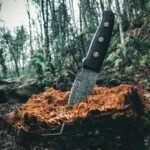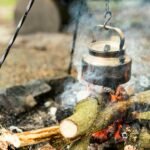As we all know, water is very important for our body. If you are planning to stay on an overnighter or anything but a long walk, you will most probably not be carrying all the water you’re gonna need. If you ever find in a survival situation, it should be one of the first things to worry about. You should be prepared with the right tools and containers to help you collect and purify water. Disclaimer: I am not a biologist and you should research the area that you live very thoroughly for any chemical waste and stuff of that nature.
In this article, I’m going to do my best to explain the best ways to collect and disinfect water. What sort of containers should you use, what to do when boiling isn’t really an option. After reading it in its entirety you should have a very decent understanding of how to disinfect water in the field.
Drinkable water
First off, when you’re searching for water, a general rule of thumb is that the faster and clearer water is better than the slow and muddy water. A good sign that the water is relatively drinkable is if there are fish swimming in the water, frogs near the water, as well as vegetation. Mosquitoes are a bad sign. If it has recently rained, you really can’t know that because the water is all muddied up, but when you can and you have a choice you should check. Also, high mountain streams are generally pretty clean.
What containers should you use?
Some people say that all of your water containers should be stainless steel or something that can withstand direct flame like titanium. And they’ve got a point, of course, it’s nice to have options, but I don’t mind having a 1l plastic water bottle and a stainless steel cup to go with it. That’s because most of the water purification chemicals are for a liter of water, and I can’t find a 1-liter stainless steel water bottle.
Waterborne Pathogens
There are three common waterborne pathogens that cause most of the problems when it comes to drinking infected water. They are:
Geordia-a parasite that can cause illness with these symptoms: fatigue, nausea, diarrhea, greasy stools, loss of appetite, vomiting, bloating, abdominal cramps, weight loss, excessive gas, headaches, abdominal pain.
E.coli– a bacteria that can cause illness with these symptoms: diarrhea, which may range from mild and watery to severe and bloody, abdominal cramping, pain, tenderness, nausea, and vomiting.
Cryptosporidium-a parasite that can cause illness with these symptoms: watery diarrhea, dehydration, lack of appetite, weight loss, stomach cramps or pain, fever, nausea, vomiting.
The best, foolproof way to disinfect water
All sources agree that the best way to disinfect water and kill waterborne pathogens is through filtering and then boiling. 99% of all waterborne pathogens are killed in boiling water, but it is adviced that you first filter the water.
Filtering
Filtering when you’re in the wilderness really isn’t going to filter any parasites or bacteria, especially if all you have for filtering is a bandana. What it could do though is remove the larger particles in the water so you don’t have to drink them. (as a side note tiny microscopical viruses could be on those particles, and if you filter the particles out, there is a chance to filter some of the viruses as well)It could also slightly improve the taste.
Through a bandana– really the least effective method of filtering, it might catch some larger particles, but it’s still better than nothing. One tip I have for you is to not try to fill up your water bottle with the bandana over the hole. As you’re fumbling around you’re most probably miss some unfiltered water in. A better way is to just fill up a bottle with the water and then pour in another container through the bandana. It’s true that this way you’ll have to disinfect the first bottle, but that method is easier in my opinion
Through a sock/tied off sleeve or a piece of cloth. You are aiming to get a sock-shape then fill it up with sand, small rocks, medium and big rocks, charcoal and some leaves. this filter should be better and the coals should remove some of the bad taste from the water if there is any. Just put a piece of string around the top of the sock, and then hang it from a branch or something. put your cup at the bottom and wait.
With a tripod and three layers of filtration. Make a simple tripod out of branches, similar to something you would use to hang your pot from. then tie out a bandana at the tree ends so it slacks a bit in the center, then do this two more times beneath the first one. Fill the top with leaves and vegetation, the second one with charcoal, and the third one with fine sand. It’s good to pour water through every layer before building the next one to make sure that the water is flowing properly in the center. Now place your cup on the bottom and pour water from the top. make sure no water splashes around.
Boiling
After you have filtered your water from the larger particles, and hopefully improved the taste of it a little, it’s time to boil it to kill of most of the pathogens that make you sick. Now if you are using a stainless steel water bottle, you can boil it directly in there. Just make sure to unscrew the cap off first, and then build the fire all the way around it and to the top to sterilize the whole bottle. Otherwise, you can boil the water in a cup.
If you’re at an altitude of 5000 feet or less after you’ve hit a rawling boil your water is clean and ready to go. If you’re higher up you need to boil your water for 2 minutes just to be sure, as up there the boiling temperature is lower.
If you don’t have a metal container to boil your water in, you can actually use a plastic water bottle as well. It’s amazing but it actually works. You can cut a cup from the bottom part of the bottle, and use the top as a makeshift filter. Be advised though, that this method releases plastic into your water and is not good for your long-term health, but when you’re in a pinch it could work just fine.
If you don’t even have a plastic bottle, you can still boil water in wooden containers, or in general containers that can’t take on direct heat. Just lay some stones in the base of your fire, and then put them inside the water in the wooden container. It should start boiling, if not add more or hotter stones. It’s not the easiest method but it’s possible.
What if boiling isn’t an option?
There are some reasons you might not be able to purify water with a fire. If you’re hiking distance you really don’t have time to sit down and build a fire every time you want some fresh water. Also, fire might be prohibitet in your country during the summer months, or it might just be too dry and sunny for a fire. either way, here are the ways of purifying water without boiling.
Using chemicals
You can buy chlorine and iodine tablets or drops, and use them to purify your water. Just follow the instructions on how long to wait before drinking the water after treatment and do your research.
Using filters
It’s really nice to have something like a gravity filter or a lifestraw just for emergencies when you can’t wait. Just keep in mind that there isn’t a filter in the market today that can filtrate 100% of all waterborne pathogens. So there’s always a little bit of risk. Be really careful and do your research on how big to bacteria and parasites get and make sure your filter has small enough spores so it can catch most of them.





